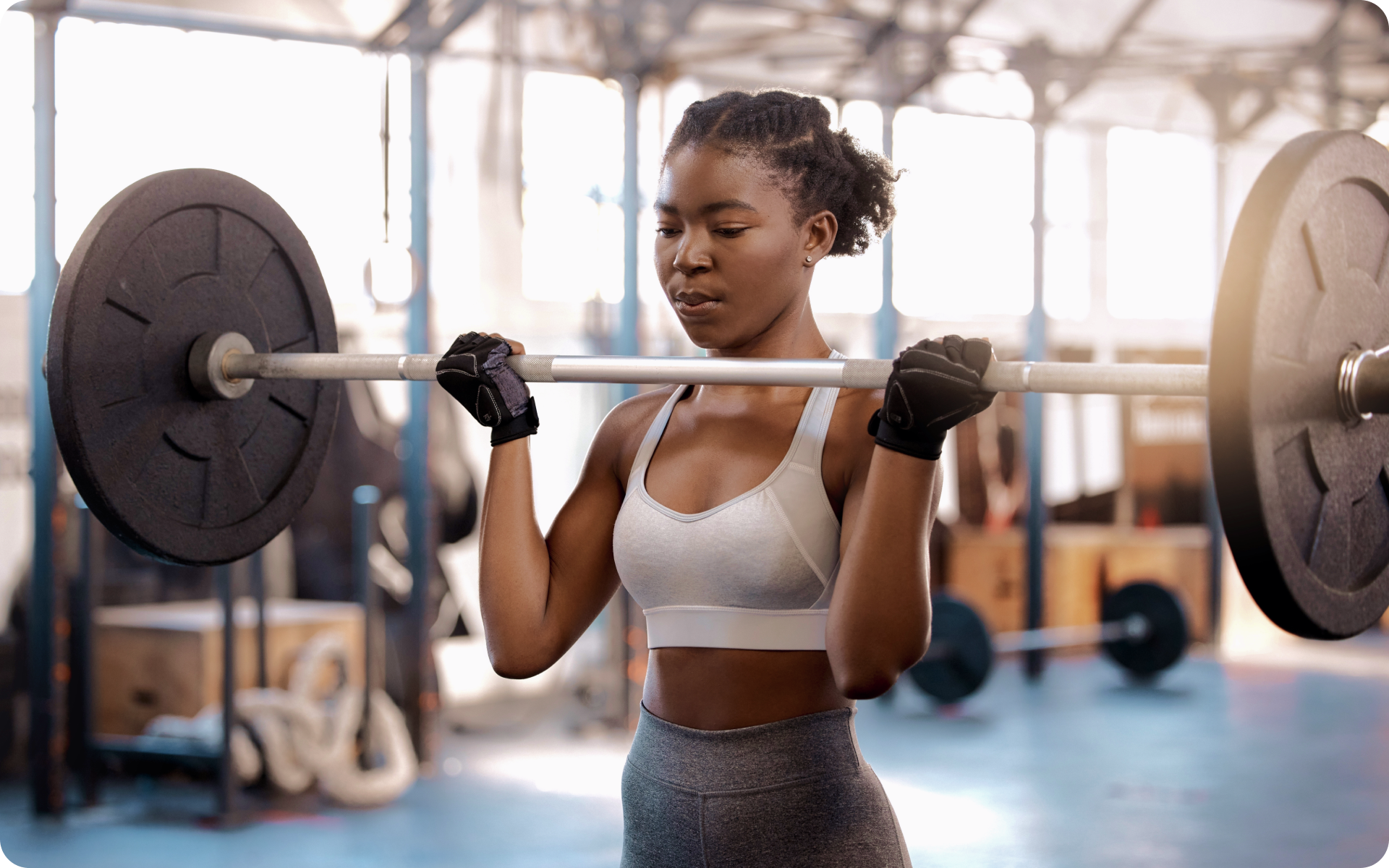We use our shoulders a lot throughout the day. Whether it’s during simple activities such as typing on our computer or phone, shrugging, or doing more manually demanding tasks like carrying groceries, working out, doing farm work, or reaching up on a shelf – shoulders are an important part of everyday activities. With this in mind, poor shoulder mobility can put a real damper on your day-to-day life. Not to mention that it can be a bit inconvenient, it is also quite uncomfortable and over time can become incredibly painful. Listed below are shoulder mobility exercises to help you prevent this condition by keeping this part of the body strong and as healthy as it can be.
Get your personalized
meal plan!
What Do Shoulder Mobility Exercises Do?
So, what are the benefits of mobility exercises? Are they that important or can you skip them the next time you are at the gym?
-
Increased Range Of Motion
The biggest benefit of any mobility exercise is its increased range of motion. Unlike flexibility, which helps you reach or stretch further, range of motion helps your joints – not just the muscles – complete any specific movement.
For instance, you are able to easily roll your shoulder on either side, reach up, or extend your arm sideways without any sudden pain, discomfort, or tightness in the shoulders.
-
Prevent Injury
While joints may not be the main thing we use in lifting, a stiff joint could lead to muscle injury. When your joint is unable to fully complete a range of motion, this adds extra pressure to the muscle, which could lead to straining or worse (3, 4).
-
Enhance Strength And Physical Performance
The smoother your joints and muscles movements are, the more you are able to move; hence, the stronger you can get at the gym and the more impressive your lifts can get. People who do mobility exercises can jump higher, squat deeper, and lift heavier.
Read More: Resistance Band Shoulder Exercises For Beginners
What Causes Lack Of Shoulder Mobility?
Shoulder tension and immobility are often caused by lifestyle factors, which include:
Stress
It may not seem like enough reason, but chronic stress is one of the major factors leading to reduced mobility, including shoulder immobility. One study published in 2014 revealed that people who suffered from chronic stress had a 30 to 70 percent more chance of suffering from immobility later in life (7).
Poor Posture
According to the National Institutes of Health newsletter, poor posture not only decreases your flexibility but also affects how well your joints move as well as your balance (2). Bending forward or hunching a lot, while texting, typing on your computer, or simply scrolling social media could lead to shoulder immobility.
Excessive Training Or Stretching
Everything including working out and stretching requires moderation. If you do it too much it could lead to straining your joints or muscles.
Lack Of Exercise
It can also lead to poor shoulder mobility, so make sure to exercise regularly!
Shoulder Stretches To Help With Mobility
Having shoulder mobility exercises as part of your workout routine is a great way to not only work on the mobility of this area but also on the definition of the muscles found there. However, before attempting any frozen shoulder exercises, it is important to stretch first.
These shoulder stretches can be used as a warmup, which according to multiple studies, has multiple benefits including improving circulation (especially to the muscles), raising your body temperature, increasing joint lubrication (which prevents injury to them), mobilizing joints, lengthening muscles, and much more (1, 5, 6).
Some upper body stretches that you should do before attempting any of the exercises are:
-
The Cross Arm Stretch
- Stand straight with your arms at your side and feet apart, about shoulder-width apart, or slightly narrower.
- With your shoulders relaxed (they are not pulled up all the way to your ears), stretch the right hand across your body at chest level towards the left side of your body.
- Place your left hand on your right elbow and push the arm in towards your chest.
- Hold this position for 30 seconds, then slowly release allowing both arms to go back to starting position.
- Switch to the other hand and repeat this process.
-
Shoulder Rolls
- Stand tall with your straight spine and core engaged.
- Relax your arms, breathe, and shrug your shoulders up toward your ears.
- Push the shoulders back and with that motion roll them down and forward, ending back at the start position.
- Keep rolling the shoulders like this for about 30 seconds.
- Stop and then repeat this motion in the other direction.
-
Thread The Needle
This stretch is said to help relieve neck and shoulder pain, mobilize your upper back, stretch the shoulders, and ultimately relax you.
- Begin by getting on all fours on a soft but firm surface– a yoga or gym mat would do.
- Ensure that your body is in a “tabletop” position. Say, for example, your hips are stacked directly above your knees and your elbows, shoulders, and wrists are placed in a straight line perpendicular to the ground.
- Lift your right hand up, sending your gaze up with it, and then follow your right hand down as you thread it beneath your left arm.
- Sink into the stretch as much as possible by keeping your hips high while allowing your chest to rest on or come close to the ground. Keep the hips pushed back and up, and avoid crunching your neck by placing some of your body weight on your left palm.
- Hold the position for 30 seconds to a minute.
- Go back to the start position (on all fours), then switch to the other side and repeat.
If you wish to cinch your waist, tone up your bat wings, blast away the muffin top – our fitness app was created to cater to all your needs! BetterMe won’t give excess weight a chance!
The Best Shoulder Mobility Exercises For A Tight Upper Body
Now that stretches are out of the way and your body is effectively warmed up, here are some simple mobility exercises to help rehabilitate your tight shoulders:
-
Shoulder Pass-Through
Also known as a PVC pass-through, it is a simple yet great workout that helps with mobility and engages the muscles around the area. While the workout is often done with a PVC pipe, you can use a broom or stick if you do not have access to this pipe.
- Begin by standing with your feet shoulder-width apart.
- With your arms in front of your body, hold your broom, stick, or pipe in an overhand grip– palms facing toward your body.
- Adjust your arm position until the arms are wider than shoulder-width apart.
- With your core engaged, slowly lift the broom, stick, or pipe above your head. Remember to breathe and keep your arms straight.
- Lift as high as what is comfortable for you, and then hold this pose for a few seconds.
- Slowly drop your arms as you return to the starting position.
- Repeat this motion 5 to 10 times.
-
Overhead Press
Not only does this exercise improve your strength and range of motion but it also works and gives great definition to your pectorals, deltoids, triceps, and trapezius muscles. Please note that this workout can be done either whole seated or standing, and you may use your body weight or free weights like dumbbells and kettlebells.
If you choose to use free weights, ensure that they are not too heavy to avoid further injuring your tight shoulders.
- Begin by standing on a gym mat with your feet about shoulder-width apart while holding your weight of choice in each hand.
- With your core engaged, lift your weights to shoulder height.
- Bend your elbows at a 90-degree angle and lift your hands and weights overhead.
- Ensure to extend through elbows during the lift.
- Hold at the top for a few seconds, then slowly drop your arms returning to the starting position.
- This counts as one rep. Do this for 10 to 12 reps.
Read More: Shoulder Flexibility: Why It Matters And How To Improve It
-
Side Lateral Raises
Like the overhead press, this workout can also be done with free weights or simply with your body weight. Free weights, however, are often preferred as they add a challenge to the workout and work the muscles more.
- Stand tall on a soft but firm surface with a dumbbell in each hand.
- At this point, your arms are at your sides with the palms facing in towards you. Keep your feet about hip-distance apart, roll your shoulders back, keep your gaze straight ahead and engage your core.
- Slightly raise both arms a couple of inches out to each side and pause.
- Continue lifting the dumbbells up and out to each side, keeping your arms almost completely straight.
- Stop once your elbows reach shoulder-height and your body is forming a “T” shape.
- Remember to keep breathing and your core engaged.
- Pause and hold this position for about five seconds.
- On an exhale, slowly lower the weights, feeling the burn as you bring your arms back to your sides.
- This counts as one rep. Do 8 to 10 reps for one set.
Alternative Shoulder Mobility Exercises With Bands
Resistance bands are a low-cost, convenient, and travel-friendly way to work out. The benefits of these bands range from helping you keep your form in check, strengthening your muscles, assuring that it is safe for use (thus less chance of injury), helping you work on your flexibility and mobility, and much more.
If you have some bands lying around at home and would like to use them as part of your shoulder mobility exercises, here are some workouts for you to try:
-
Reverse Fly
Ordinarily, this exercise is done with dumbbells. However, if you do not have some, a resistance band works just as well.
- Begin by placing your band on the floor in front of you, and then stepping at the middle of it with both feet. It is important to step in the middle as this leaves the same length of the band on either side of you.
- Bend over and hold the band ends on each hand.
Optional: Cross the ends to opposite hands, so the band crosses in front of your lower legs forming an X.
- Bend over slightly. Your lower back should be parallel to the floor, knees slightly bent, and your spine long and neutral. Do not curve or arch your spine/back.
- Slowly stretch your hands upwards and outwards away from your body. Lift your hands high until they reach about chest level or higher if you can.
- Pause for five to ten seconds.
- Slowly lower the bands; your arms go back to the start position.
- Do 8 to 10 reps.
-
Front Raises
- Holding the handle of a resistance band in each hand, step on the middle of the band with both feet.
- Ensure that you are standing up straight with your chest out, back flat, and core tight. Remember to keep breathing.
- Lift your arms straight in front of you and stop once your hands are about shoulder level.
- Do not lock your elbows and make sure that your thumbs are facing up.
- Pause here for a few seconds before dropping your arms back down to the starting position.
- This is one rep.
-
Shoulder Extension
- Attach the resistance band to a secure anchor above your head. This could be a pull-up bar, a hook, or a tree branch if you are outside.
- Stand tall, reach up, and grab the band with your left hand.
- Keeping your elbow straight, extend your arm backward towards your body pulling the band towards you.
- Pause briefly at the bottom, feeling the tension in your arm and shoulder.
- Stop pulling and return to the starting position.
- Do this for eight reps before switching to your right hand and repeating the motion plus reps.
BetterMe is your fast-track ticket to a long-lasting weight loss! Tailor your fitness journey and maximize your results with just a couple of swipes!
-
Band Pull-Apart
Pull-apart double can be both a shoulder stretch and mobility exercise.
- Stand up straight on a gym mat with your core tight and a resistance band held in both arms in front of you.
- Lift both arms until they and the band are right around chest height level. Keep the arms shoulder-width apart.
- Keep your spine long, elbows bent slightly, and core tight. Also, remember to breathe.
- Pull the band apart on either side of the body as far as you can. Be sure to squeeze your shoulder blades together.
- Hold this position for a few seconds, then slowly return to starting position.
-
Chest Expansion
Chest expansions are a great example of resistance band upper body stretches that should be done as a warmup before attempting any shoulder-intensive exercises. Its stretch helps relieve any stress or tightness that you may have in your upper back, chest, and shoulders.
- Stand up straight while holding a band behind you and just under your butt.
- Keep the arms extended with your hands about shoulder-width apart.
- Slowly pull your hands backward while keeping the arms straight.
- As you do this, roll your shoulders backward, raise your chin, and push your chest out and up like you are “opening” it up.
- Hold here for 5 to 10 seconds before going back to the start position.
- Repeat as desired.
FAQs
Can You Regain Shoulder Mobility?
Whether you lost your mobility due to an injury, surgery, illness, or lack of a proper workout routine, shoulder immobility is not a death sentence. With patience, dedication to mobility stretches and exercises, as well as help from a doctor or a personal trainer, you may regain your mobility.
How Can I Improve Shoulder Mobility?
Other than doing shoulder mobility exercises, you could improve your shoulder mobility by also working on improving your posture and reducing your stress levels.
The Bottom Line
Shoulder mobility exercises are a great preventative measure to ensure that your shoulders and upper body remain healthy and flexible. Not only will they help you get on with your day-to-day tasks easily but they also work on the strength and definition of this body part. Remember to take things easy and pace yourself. If you are still experiencing any discomfort after trying these stretches and exercises, please see a doctor.
DISCLAIMER:
This article is intended for general informational purposes only and does not serve to address individual circumstances. It is not a substitute for professional advice or help and should not be relied on for making any kind of decision-making. Any action taken as a direct or indirect result of the information in this article is entirely at your own risk and is your sole responsibility.
BetterMe, its content staff, and its medical advisors accept no responsibility for inaccuracies, errors, misstatements, inconsistencies, or omissions and specifically disclaim any liability, loss or risk, personal, professional or otherwise, which may be incurred as a consequence, directly or indirectly, of the use and/or application of any content.
You should always seek the advice of your physician or other qualified health provider with any questions you may have regarding a medical condition or your specific situation. Never disregard professional medical advice or delay seeking it because of BetterMe content. If you suspect or think you may have a medical emergency, call your doctor.
SOURCES:
- Effects of warming-up on physical performance: a systematic review with meta-analysis (2010, pubmed.ncbi.nlm.nih.gov)
- Getting It Straight Improve Your Posture for Better Health (2017, newsinhealth.nih.gov)
- Mobility, proprioception, strength and FMS as predictors of injury in professional footballers (2016, ncbi.nlm.nih.gov)
- Stretching and injury prevention – An obscure relationship (2004, researchgate.net)
- The effect of warm-ups with stretching on the isokinetic moments of collegiate men (2018, ncbi.nlm.nih.gov)
- The Importance of Warm Up and Cool Down Article (2020, researchgate.net)
- Work-related stress in midlife is associated with higher number of mobility limitation in older age—results from the FLAME study (2014, ncbi.nlm.nih.gov)















